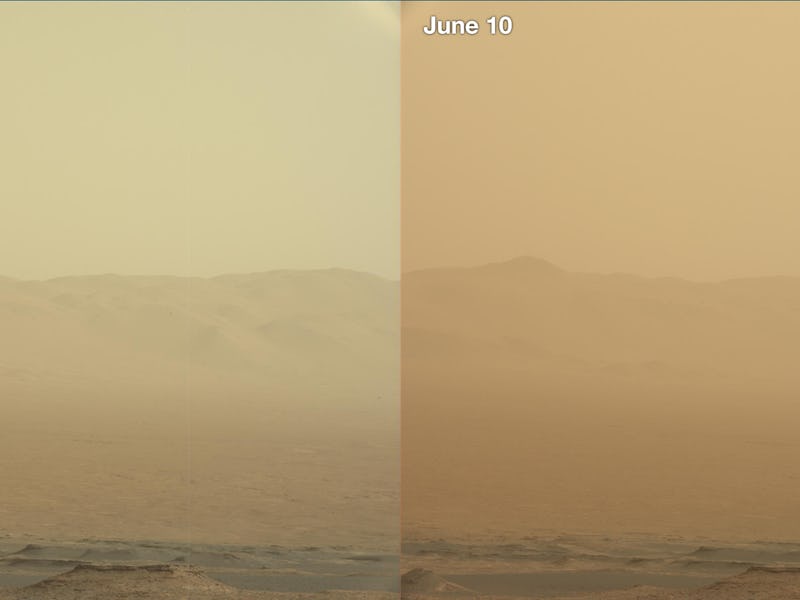NASA: Opportunity Will 'Ride Out' Dust Storm, But Future Humans Might Not
The little robot is in sleeping through it.

A fast-moving dust storm blotted the sun out of the Martian sky above NASA’s Opportunity Rover this week, forcing the 15-year-old droid to temporarily shut down to conserve energy. In a conference call with reporters on Wednesday, NASA Jet Propulsion Laboratory physicist John Callas, Ph.D. assured the public that the rover “should be able to ride out the storm.” But it soon became clear how much of Martian weather remains a mystery, and how much we are still woefully unprepared to colonize the red planet.
Opportunity, which is solar powered, has spent the past week and a half in and out of sleep mode, coping with reduced power and sending measurements on atmospheric opacity back to Earth. “It’s completely black on Mars. It’s completely dark,” according to Callas, who is also Opportunity’s project manager. From June 2 to 10, the dust cloud enveloping Opportunity brought atmospheric opacity, measured as tau, from 0.6 to 10.8 — a change visible in the following set of images sent back by Opportunity as the storm overcame it. Future Martian colonists will need to be prepared for situations like this:
Atmospheric opacity images from the Opportunity rover on Mars as the sun is was blotted out from the sky last week. (Far left is Saturday, June 2nd. Far right is Sunday, June 10th.)
As intense as it looks, this dust storm (like most dust storms on Mars) is very different than you might imagine. It’s nothing like the havoc wrought by the dust storm in the 2015 science fiction film The Martian for example — where a potato-eating American spaceman played by Matt Damon gets stranded on the planet due to a dust storm with hurricane-level winds that ripped through his team’s research station.
NASA researchers say that even the strongest winds during a dust storm on Mars tend to max out at around 60 miles per hour, below the threshold defining a hurricane from a tropical cyclone here on Earth. Further lightening the load is the fact that Mars’ atmosphere is about 1 percent the density of Earth’s own — meaning that the wind has less of the gas and pressure needed to inflict that much damage.
That said, Mars’ dust storms are still dangerous — just not in the way that desert sandstorms on Earth are. They’re truly made of dust, for starters, close in consistency to talcum powder or confectioner’s sugar, and that dust holds a slight charge of static electricity that can accumulate and discharge in unpredictable ways. A presentation delivered at the 2017 Lunar and Planetary Institute meeting suggested that electrical arcing in Martian dust storms could resemble terrestrial thunderstorms on Earth and are likely to pose a threat to vehicle take-offs, ascents, and orbital insertions. Other concerns include the potentially toxic content within these dust clouds, which is believed to include hexavalent chromium and perchlorates (salts of perchloric acid).
When Opportunity’s energy production dropped to only 22 watt-hours on Sunday, Callas declared a precautionary spacecraft emergency, putting plans into motion to conserve the rover’s energy until the dust settles. By weathering this storm, the beloved rover is driving home a critical message about Martian dust storms, according to the director of NASA’s Mars Exploration Program, Jim Watzin: just how important Martian meteorology will be for future manned missions to the planet.
“The big takeaway here is that we really need to understand these storms to the degree that we can have some level of forecasting capability,” Watzin told reporters. “We would not want to have a crew, if you will, operating remotely from their base and be caught off-guard with a storm like this, and have difficulty getting back home.”
“In order to support humans safely — just as you do with difficult operations here on Earth — you need to have an understanding of the circumstances in which they’re gonna work. Being able to forecast the weather and environmental conditions is just one of the most fundamental things that we’d want to be able to support the crews with.”